Initially this guide displays common birds of all types that are flying right now in our area. Use the selectors below to view rare birds, view birds flying any time, restrict the output to a certain shape of bird, or search by name.
New Mexico is on the western edge of the Central Flyway which is one of the major migration pathways between north and south for birds traveling between breeding and wintering grounds along the Rocky Mountains. This has resulted in the state having an incredible diversity of birds with over 550 different species reported. A little more than half of this number are sighted annually on the Pajarito Plateau. Some of these birds are full-time residents, some migrate here for a few weeks or months, and other are only seen briefly as they pass through the region.
This guide features many of the birds known to frequent Los Alamos county by when they are likely to be seen in the area. You can get additional information on local birds by joining PEEC Birders or going to the eBird website. eBird also includes lists of rare bird sightings and birding hot spots.
Bird References
Birdweb
Cornell Lab of Ornithology
eBird
eNature
Institute for Bird Populations
National Audubon Society
New Mexico Ornithology Society
What Bird
xeno-canto
Subject Area Experts (all guides)
Steve Cary (butterflies)
Beth Cortright (insects)
Terry Foxx (invasive plants)
Leslie Hansen (mammals)
Richard Hansen (fish, mammals)
Dorothy Hoard (butterflies, trees)
Chick Keller (flowers, herbarium)
Shari Kelley (geology)
Kirt Kempter (geology)
Garth Tietjen (reptiles)
David Yeamans (birds)
Web Development and Content Management
Pat Bacha
Jennifer Macke
Graham Mark
Akkana Peck
Contact
Please contact us for local nature questions and sightings. We welcome comments, corrections, and additions to our guides.
For more information about local nature, please visit our Nature Blog or subscribe to PEEC This Week.
Make Selection
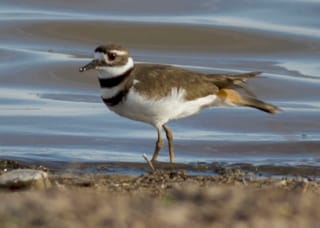 Photo: adult by Mouser Williams 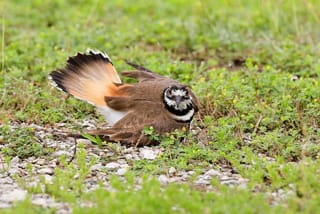 Photo: adult defending territory by Bob Walker  Photo: nest with eggs by J.N. Stuart |  KilldeerKILL (Charadrius vociferus, Aegialitis vocifera)Family: Charadriidae (Plovers and Lapwings) Size: 9 - 11 in (23 - 28 cm) Flies: Feb 15 - Jul 01 and Aug 07 - Oct 07 Morphology: adults are slender with long tails and wings; body is brown on top and white below with two black bands on the chest and black and white patches on the face; orange rump visible when in flight; immatures have a single breast band Status: native; uncommon Food source: mostly insects with some spiders, earthworms, crayfish, and snails Habitat: open country short grass,shoreline Though technically a shorebird, Killdeer can often be found in pastures and fields far from water. When foraging, they will typically run a few steps, pause, and then run again only to stop and peck at the ground when they see something to eat. Nests are typically on the ground out in the open and usually have no nesting material. Down-covered young leave the nest soon after hatching. They feed themselves but are tended by both parents for several more weeks. The parents rely on distraction displays to protect their young. Killdeer have a “broken wing display” technique that they use to distract predators while leading the threat away from their offspring. Info Photos Distribution Frequency |
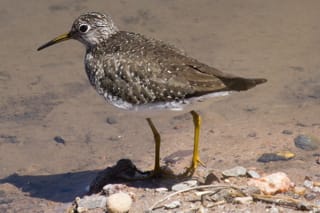 Photo: breeding adult by Rozelle Wright 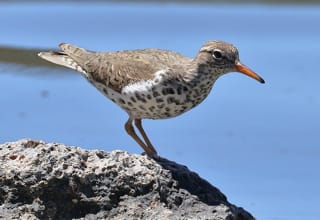 Photo: breeding male by Bob Walker 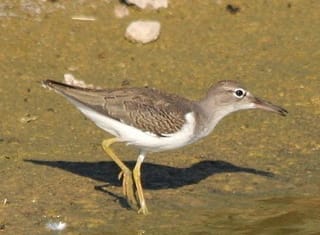 Photo: non-breeding adult by J.N. Stuart |  Spotted SandpiperSPSA (Actitis macularius)Family: Scolopacidae (Sandpipers, Phalaropes, and Allies) Size: 7.5 - 7.5 in (19 - 19 cm) Flies: Apr 15 - Sep 15 Morphology: medium-sized bird with a tapered body, long tail, rounded breast, and a white stripe along the wing visible in flight; breeding adults have dark spots on a white breast and an orange bill; non-breeding adults have a plain white breast and pale yellow bill; females are slightly larger than males Status: native; locally common Food source: variety of insects, worms, crabs, crayfish, mollusks, and small fish Habitat: waterways Typical location: Ashley Pond, Rio Grande The Spotted Sandpiper is the most widespread sandpiper in North America but seldom seen in flocks. They are usually seen feeding on the edges of ponds and streams. Spotted Sandpipers have a distinctive walk sometimes called “teeter tail” — constantly bobbing the body up and down. Birds teeter faster when alarmed, angry, or courting. Females may sequentially mate with up to five males during a single breeding season. After mating, they will lay eggs and leave each male to incubate and raise the their young. Chicks leave the nest soon after hatching and are capable of feeding themselves. They will teeter just like the male parent who is tending them. First flight is around three weeks of age. Info Photos Distribution Frequency |
